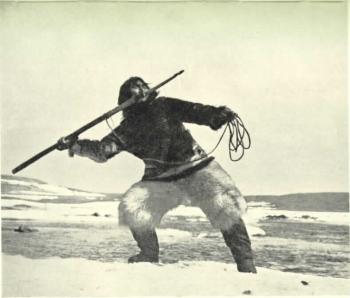http://www.stummfilm-silentmovie.de

Nanook of the North (1922)
english
Der Klassiker des Dokumentarfilms und zugleich der erste große Film, der in der Aktis gedreht wurde. Robert Flaherty zeigt die Freuden und Mühen des rauen Lebens des Jägers Nanuk und seiner Familie im hohen Norden Kanadas in den frühen 20er Jahren des letzten Jahrhunderts. Flaherty beobachtet Szenen des Lebens und der Liebe, Humor und Zärtlichkeit der Mutter und der Eskimokinder, poetische Bilder, die ganze Schönheit der großartigen Eiswüste. Dieses Meisterwerk von 1922 bezaubert noch heute durch seine Klarheit und Einfachheit. Flaherty verbrachte mehrere Monate in der Arktis, um den Eskimo Nanuk und seine Familie bei den alltäglichen Verrichtungen Jagd, Fischfang, Iglubau, Fellhandel, Pflege der Kinder, Betreuung der Schlittenhunde mit der Kamera zu beobachten. Der Film zeigt die Härte dieses Lebens, die Schönheit der Eislandschaft und die naive Fröhlichkeit der Menschen. Vier Jahre dauerte es, bis Robert J. Flaherty 50 000 Dollar aufgetrieben hatte, mit deren Hilfe er 1920 an die kanadische Hudson Bay aufbrach, um das Leben der Inuit zu filmen. Er schuf einen neuen Stil und ein bewegendes Meisterwerk der Filmgeschichte. Statt abstrahierend über das Leben der Eskimos zu berichten, konzentrierte sich Flaherty auf den Alltag und das individuelle Schicksal weniger Menschen. Ob der Eskimo Nanuk zur Jagd ging, mit seiner Familie ein Iglu baute oder Schlittenhunde versorgte :
Der "Vater des Dokumentarfilms" war mit der Kamera dabei. In phantastischer Landschaft entstanden eindringliche Bilder vom Überlebenskampf jenseits der Zivilisation und des Fortschritts.
Nanook of the North is a silent documentary film by Robert J. Flaherty, released in 1922. In the tradition of what would later be called salvage ethnography, Flaherty captured the struggles of the Inuit Nanook and his family in the Canadian arctic. The film is considered the first feature-length documentary, though Flaherty has been criticized for staging much of the action and distorting the reality of his subjects' lives.
The film was shot near Inukjuak, on Hudson Bay in arctic Quebec, Canada. Having worked as a prospector and explorer in arctic Canada among the Inuit, Flaherty was familiar with his subjects and set out to document their lifestyle. Flaherty had shot film in the region prior to this period, but that footage was destroyed in a fire started when Flaherty dropped a cigarette onto the original camera negative (which was highly flammable nitrate stock). Flaherty therefore made Nanook of the North in its place. Funded by French fur company Revillon Freres, the film was shot from August 1920 to August 1921.
As the first nonfiction work of its scale, Nanook of the North was ground-breaking cinema. It captured an exotic culture in a distant location, rather than a facsimile of reality using actors and props on a studio set. Traditional Inuit methods of hunting, fishing, igloo-building, and other customs were shown with accuracy, and the compelling story of a man and his family struggling against nature met with great success in North America and abroad.
Flaherty has been criticised for deceptively portraying staged events as reality. Much of the action was staged and gives an inaccurate view of real Inuit life during the early 20th century. "Nanook" was in fact named Allakariallak, for instance, while the "wife" shown in the film was not really his wife. And although Allakariallak normally used a gun when hunting, Flaherty encouraged him to hunt after the fashion of his ancestors in order to capture what was believed to be the way the Inuit lived before European influence. The ending, in which Nanook and his family are supposedly in peril of dying if they can't find shelter quickly enough, was implausible, given the reality of nearby French-Canadian and Inuit settlements during filming (although Allakariallak himself died of exposure two years after the film was made, when he was caught in a snowstorm). On the other hand, while Flaherty made his Inuit actors use spears instead of guns during the walrus and seal hunts, the hunting itself did involve actual wild animals.
Flaherty defended his work by stating that a filmmaker must often distort a thing to catch its true spirit. Later filmmakers have pointed out that the only cameras available to Flaherty at the time were both large and immobile, making it impossible to effectively capture most interior shots or unstructured exterior scenes without significantly modifying the environment and subject action. For example, the Inuit crew had to build a special three-walled igloo for Flaherty's bulky camera so that there would be enough light for it to capture interior shots.
At the time, few documentaries had been filmed and there was little precedent to guide Flaherty's work. Nonetheless, since Flaherty's time both staging action and attempting to steer documentary action have come to be considered unethical among documentarians, as has any sort of re-enactment which is not introduced as or immediately obvious as a re-enactment. wikipedia
http://filmmusik.at/ http://filmmusik.at/English/Gerhard-Gruber-Silentfilm-English.html http://filmmusik.at/Stummfilmpianist/Gerhard-Gruber-Stummfilmpianist.html